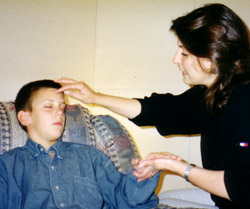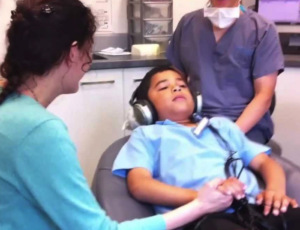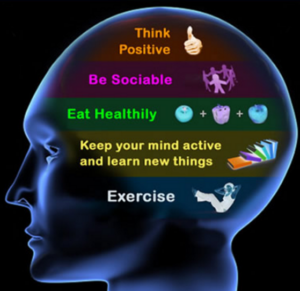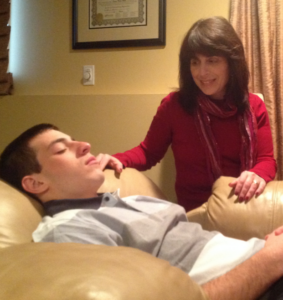 Children are often better candidates for hypnosis than adults, says one clinical psychologist, and the process can help resolve such problems as pain, anxiety, bed wetting, and asthma.
Children are often better candidates for hypnosis than adults, says one clinical psychologist, and the process can help resolve such problems as pain, anxiety, bed wetting, and asthma.
Robert Shacter of New York’s Mount Sinai School of Medicine talked about children and hypnosis on The Saturday Early Show. He says children tend to respond to hypnotic suggestion better than adults because they are more in touch with their imaginations.
Children can be hypnotized as early as age 3, he says, adding, “But in my personal experience, I have found that children ages 5 or older respond best to the treatment.”
The easiest way to hypnotize a child is to have them focus on a point, he explains. They will do that until their eyes begin to feel heavy, and they become sleepy. You now have them in a trance-like state. Once they are in this state, you begin to tell the child stories that can alleviate whatever problems they may have.
What role, if any, does the parent play during a hypnosis session?
As in any therapy, it is important for parents to know what is going on. But in the actual session the parent is either not there or in the background. So, they really don’t play any part in the actual therapy.
don’t play any part in the actual therapy.
How many times does a typical child visit a hypnotist?
Most children attend 4 to 8 sessions with a qualified hypnotist. During that time, the hypnotist can teach a child how to hypnotize himself.
How do I know if my child if a candidate for hypnosis?
Most children are good candidates. It just depends on whether the problems they are having can be helped by hypnosis.
Here are some of the problems that might be helped by hypnosis:
- Hypnosis is very effective at alleviating the pain of children undergoing cancer treatments. What we do is help the child go somewhere else, away from the pain. By accessing the unconscious, the child creates images that forces them to focus on something other than the pain they are feeling.
 For example, if you squeezed your hand very tightly to the point that it hurt and then someone asked you to focus on something else, you would not be as aware of the pain in your hand.
For example, if you squeezed your hand very tightly to the point that it hurt and then someone asked you to focus on something else, you would not be as aware of the pain in your hand.
- A child who is anxious often breathes more quickly and has a higher heart rate. With hypnosis, we can teach them to breathe more slowly, lower their heart rate and take them away from whatever is making them anxious.
- Bed Wetting.Many doctors prescribe medicine for children who have a bed-wetting problem. But now more physicians are turning to hypnosis, which has very positive results. Part of the reason that it works so well is that kids play an active role in their treatment rather than just taking a pill.
- When children with asthma feel their throats constricting, they begin to feel anxious and breathe more heavily. With hypnosis, you teach the child to calm down and bring them to another place.
How effective is hypnosis in children?
In the right child, hypnotism can be very successful. Remember: There are some children who have a harder time letting go. But for those who can, the results can be very positive. Another plus of hypnosis is that unlike drugs, the risk of harm is low.
Why aren’t more doctors using hypnotism?
It’s just not taught that much in schools, and some people still don’t want to recognize it as a viable alternative. However, it is becoming more popular, and many insurers will cover it.
By: Ellen Crean CBS News

 Clinical hypnotherapy has been gradually gaining momentum in the medical mainstream as a legitimate tool supporting healthy change. I have been in practice since 2001, and in the past 5 years the number of clients looking for help related to medical conditions has grown significantly.
Clinical hypnotherapy has been gradually gaining momentum in the medical mainstream as a legitimate tool supporting healthy change. I have been in practice since 2001, and in the past 5 years the number of clients looking for help related to medical conditions has grown significantly.
The value of hypnotherapy in the clinical setting is nothing new. In fact, research has been validating this application for 25 years or more. Its just taken a while for results to filter through to the mainstream.
A University of Florida study revealed that learning self-hypnosis gives a patient greater control over stress, anxiety and pain of medical operations and childbirth.
“Training patients in hypnosis prior to undergoing surgery is a way of helping them develop a sense of control,” says Dr. Paul Schauble, “It also helps them better understand what they can do to bring about a more satisfying and rapid recovery.”
Dr. Schauble also said, “We’ve found, in working with individual patients, that they often feel literally stripped of control when they go into the hospital.”
“The surgeon may do a good job of explaining the surgery, but patients’ anxiety may make it difficult for them to absorb or comprehend. This can result in undue apprehension that can create complications or prolonged recovery.”
Hypnotherapy is so effective because it accesses the subconscious mind, the home of all habits, values, values and beliefs. It is also the control center, regulating all physical and emotional functions whether we are consciously aware of it or not.
Another study tested the effectiveness of a 15-minute pre-surgery hypnosis session versus an empathic listening session with 200 breast cancer patients. Results showed hypnosis patients reported less post-surgical pain, nausea, fatigue and discomfort.
 This study also reported that the hypnosis group saved $772/patient mainly due to reduced surgical time. These patients also required less analgesic lidocaine and the sedative propofol during surgery. (Journal of the National Cancer Institute 2007)
This study also reported that the hypnosis group saved $772/patient mainly due to reduced surgical time. These patients also required less analgesic lidocaine and the sedative propofol during surgery. (Journal of the National Cancer Institute 2007)
Hypnotherapy isn’t difficult to do, it feels really good, and in addition to physically preparing patients for surgery it also offers sense of peaceful calming confidence. Individuals, both young and old, feel in relaxed, focused and confidently in control.
This study looked at the effects of hypnosis/guided imagery on the postoperative course of children. Reports validated significantly lower postoperative pain ratings and shorter hospital stays. Anxiety was decreased for the guided imagery group but increased postoperatively for the control group. This study demonstrates the positive effects of hypnosis/guided imagery for the pediatric surgical patient. (Journal of Developmental & Behavioral Pediatrics 1996)
By: Paul Gustafson RN CH
 Hypnosis is synonymous with stage entertainment where the performer puts volunteers from the audience into a trance and commands them to do embarrassing things.
Hypnosis is synonymous with stage entertainment where the performer puts volunteers from the audience into a trance and commands them to do embarrassing things.
This makes it sound like a joke, but in fact hypnosis is a real phenomenon and it is proving increasingly useful to psychologists and neuroscientists, granting new insights into mental processes and medically unexplained neurological disorders.
That’s according to David Oakley and Peter Halligan who have written an authoritative new review, debunking hypnosis myths, and covering ways that neuroscience is shedding light on hypnosis and ways hypnosis is aiding neuroscience.
Despite popular folklore, hypnosis is not a form of sleep (this misconception isn’t helped by the fact that hypnosis studies typically label the control condition the “waking state”). However, Oakley and Halligan say new brain imaging findings do support the contention that hypnosis is a distinct form of consciousness.
After successful hypnotic induction, which involves using mental strategies to reach “a focused and absorbed attentional state”, participants show reduced activity in parts of the brain’s default mode network together with increased activity in prefrontal attentional systems. Oakley and Halligan concede that “it remains to be seen if these particular changes are unique to hypnosis.”
After hypnotic induction (or in some cases even without it) participants exposed to suggestive statements can experience altered perceptual or bodily sensations.
For instance, told that their arm is getting heavier and they cannot move it, a suggestible participant may experience paralysis of the arm. Sceptics may wonder  about the veracity of these experiences but brain imaging results are indicating they are real and not merely imagined.
about the veracity of these experiences but brain imaging results are indicating they are real and not merely imagined.
Consider a study of participants hypnotized and induced to see colorful Mondrian images in grey. Brain scan results of these participants showed altered activity in fusiform regions involved in color processing, and crucially such changes weren’t observed when the participants merely imagined the Mondrians in grey.
Another study showed that the famous Stroop effect disappeared when hypnotized participants received the suggestion that they would see words as meaningless symbols.
Another line of research explores the correlates of hypnotic suggestibility. Apparently, it is a highly stable trait and it is heritable.
It doesn’t correlate with the main personality dimensions but does correlate with creativity, empathy, mental absorption, fantasy proneness and people’s expectation that they will be prone to hypnotic procedures.
 Many neurological symptoms are medically unexplained with no apparent organic cause and it is here that hypnosis is proving especially useful as a new way to model, explore and treat people’s symptoms.
Many neurological symptoms are medically unexplained with no apparent organic cause and it is here that hypnosis is proving especially useful as a new way to model, explore and treat people’s symptoms.
For instance people can be hypnotized to experience limb paralysis in a way that appears similar to the paralysis observed in conversion disorder.
People can also be hypnotically induced to experience the sense that there is a stranger looking back at them when they peer in a mirror – an apparent analogue of the real “mirrored-self-misidentification delusion”.
Hypnosis research is also exposing the apparent volitional element to mental phenomena previously considered automatic.
For example, a patient who experienced face-color synaesthesia received post-hypnotic suggestion that abolished the colors she usually sees with faces (as confirmed by a color-naming task in which faces no longer had an interfering effect).
“The psychological disposition to modify and generate experiences following targeted suggestion remains one of the most remarkable but under-researched human cognitive abilities given its striking causal influence on behavior and consciousness,” said Oakley and Halligan. (Oakley DA, and Halligan PW 2013)

Hypnosis has been an effective tool in the obesity battle. Here are 4 studies supporting the effect of weight loss hypnosis.
 Weight loss continues 2 years later: 109 people completed a behavioral treatment for weight management either with or without the addition of hypnosis. At the end of the 9-week program, both interventions resulted in significant weight reduction. At 8-month and 2-year follow-ups, the hypnosis subjects were found to have continued to lose significant weight, while those in the behavioral-treatment-only group showed little further change. (Journal of Consulting and Clinical Psychology)
Weight loss continues 2 years later: 109 people completed a behavioral treatment for weight management either with or without the addition of hypnosis. At the end of the 9-week program, both interventions resulted in significant weight reduction. At 8-month and 2-year follow-ups, the hypnosis subjects were found to have continued to lose significant weight, while those in the behavioral-treatment-only group showed little further change. (Journal of Consulting and Clinical Psychology)
Weight loss hypnosis 30 times more effective: Researchers investigated effects of hypnosis in weight loss for 60 females who were at least 20% overweight. Treatment included group hypnosis with metaphors for ego-strengthening, decision making and motivation, ideomotor exploration in individual hypnosis, and group hypnosis with maintenance suggestions. Hypnosis was more effective than a control group 17lbs vs. 0.5 lbs on follow-up. (Cochrane, Gordon; Friesen, J 1986)
Hypnosis clients lost more than 90% of non-hypnosis clients: Researchers analyzed 18 studies comparing a cognitive behavioral therapy, such as relaxation training, guided imagery, self-monitoring or goal setting with the same therapy plus hypnosis. Those who received the hypnosis lost more  weight than 90 percent of the non-hypnosis, and maintained the weight loss two years after treatment ended. (Allison DB, Faith MS. 1996)
weight than 90 percent of the non-hypnosis, and maintained the weight loss two years after treatment ended. (Allison DB, Faith MS. 1996)
Hypnosis doubles effect of dieting: An analysis of five weight loss studies reported in the Journal of Consulting and Clinical Psychology in 1996 showed that hypnosis can more than double the effects of traditional weight loss approaches. (Journal of Consulting and Clinical Psychology in 1996)
Contact Paul for a free consultation: 888-290-3972 // info@burlingtonhypnosis.com

 Hypnotherapy is an evidence-based treatment for addiction, which can also be used to treat a variety of other psychological difficulties. Hypnotherapy combines the psychological process of hypnosis with psychotherapy. Hypnotherapy is conducted by a trained therapist, typically a registered psychologist, with a client who is informed about and understands and consents to the process.
Hypnotherapy is an evidence-based treatment for addiction, which can also be used to treat a variety of other psychological difficulties. Hypnotherapy combines the psychological process of hypnosis with psychotherapy. Hypnotherapy is conducted by a trained therapist, typically a registered psychologist, with a client who is informed about and understands and consents to the process.
Hypnosis is an altered state of consciousness, known as a trance state, which is deliberately induced by one person—the hypnotist or hypnotherapist—on another individual person or group of people—the hypnotic subject or subjects. The change in consciousness that occurs under hypnosis is more than just a feeling, it can actually be measured and observed on the EEG readings of the brains of hypnotic subjects.
Self-hypnosis is the practice of inducing hypnosis in oneself, and in fact, all hypnosis is a form of self-hypnosis. The main distinction between hypnosis and self-hypnosis is simply that self-hypnosis requires an understanding of how to induce hypnosis in yourself, whereas, with regular hypnosis, the hypnotic subject can benefit from hypnosis with no prior knowledge.
How Hypnotherapy Helps With Addiction
While in a hypnotic trance, the person being hypnotized, or hypnotic subject, is more open to suggestion by the hypnotist or hypnotherapist than they are in their usual fully alert state.
They generally become more passive and compliant with role-playing as directed by the hypnotist or hypnotherapist. Under  hypnosis, people can become more imaginative, more open to fantasy, and sometimes, more able to access long-forgotten memories.
hypnosis, people can become more imaginative, more open to fantasy, and sometimes, more able to access long-forgotten memories.
This relaxed and suggestible state can help people to get a different perspective on their addictive behaviors. What normally seems impossible—quitting a substance or behavior that is central to one’s existence—can seem achievable and desirable.
People undergoing hypnotherapy often get in touch with their feelings of personal mastery and power and feel able to “unlock” themselves from long-term behavior patterns that were previously inflexible and rigid.
There are many myths about hypnosis and hypnotherapy, and many of them raise the issue of whether or not hypnosis is safe. While it is safe to engage in hypnotherapy with a trained hypnotherapist, going into the experience worrying about your safety is not a good mindset for the relaxation that is central to the approach.
Therefore, if you feel anxious, worried, or suspicious about hypnosis, hypnotherapy, or your hypnotherapist, it probably is not an approach you would get much benefit from.
In some instances, people are capable of unusual mental and physical feats when they are under the influence of hypnosis. Their feelings and behaviors can also be influenced after they have come out of a hypnotic trance.
This is the main reason that hypnosis or hypnotherapy can appeal to people with addictions, as hypnosis can profoundly help people to strengthen their willpower and allow them to use their best judgment in overcoming their addictive urges and cravings.
However, those who think that hypnosis is somehow magical, and will erase their addiction in a single session are likely to be disappointed. Hypnotherapy is is a tool to unlock human potential, not a magic formula.
Hypnosis can help people to address both their addictions and associated problems, but these issues are complex and challenging both for the client and for the therapist, and hypnotherapy does not work for everyone.
By: Elizabeth Hartney, PhD
 Children are often better candidates for hypnosis than adults, says one clinical psychologist, and the process can help resolve such problems as pain, anxiety, bed wetting, and asthma.
Children are often better candidates for hypnosis than adults, says one clinical psychologist, and the process can help resolve such problems as pain, anxiety, bed wetting, and asthma. don’t play any part in the actual therapy.
don’t play any part in the actual therapy. For example, if you squeezed your hand very tightly to the point that it hurt and then someone asked you to focus on something else, you would not be as aware of the pain in your hand.
For example, if you squeezed your hand very tightly to the point that it hurt and then someone asked you to focus on something else, you would not be as aware of the pain in your hand.
 Clinical hypnotherapy has been gradually gaining momentum in the medical mainstream as a legitimate tool supporting healthy change. I have been in practice since 2001, and in the past 5 years the number of clients looking for help related to medical conditions has grown significantly.
Clinical hypnotherapy has been gradually gaining momentum in the medical mainstream as a legitimate tool supporting healthy change. I have been in practice since 2001, and in the past 5 years the number of clients looking for help related to medical conditions has grown significantly.
 This study also reported that the hypnosis group saved $772/patient mainly due to reduced surgical time. These patients also required less analgesic lidocaine and the sedative propofol during surgery. (Journal of the National Cancer Institute 2007)
This study also reported that the hypnosis group saved $772/patient mainly due to reduced surgical time. These patients also required less analgesic lidocaine and the sedative propofol during surgery. (Journal of the National Cancer Institute 2007) Hypnosis is synonymous with stage entertainment where the performer puts volunteers from the audience into a trance and commands them to do embarrassing things.
Hypnosis is synonymous with stage entertainment where the performer puts volunteers from the audience into a trance and commands them to do embarrassing things. about the veracity of these experiences but brain imaging results are indicating they are real and not merely imagined.
about the veracity of these experiences but brain imaging results are indicating they are real and not merely imagined. Many neurological symptoms are medically unexplained with no apparent organic cause and it is here that hypnosis is proving especially useful as a new way to model, explore and treat people’s symptoms.
Many neurological symptoms are medically unexplained with no apparent organic cause and it is here that hypnosis is proving especially useful as a new way to model, explore and treat people’s symptoms.
 Weight loss continues 2 years later: 109 people completed a behavioral treatment for weight management either with or without the addition of hypnosis. At the end of the 9-week program, both interventions resulted in significant weight reduction. At 8-month and 2-year follow-ups, the hypnosis subjects were found to have continued to lose significant weight, while those in the behavioral-treatment-only group showed little further change. (Journal of Consulting and Clinical Psychology)
Weight loss continues 2 years later: 109 people completed a behavioral treatment for weight management either with or without the addition of hypnosis. At the end of the 9-week program, both interventions resulted in significant weight reduction. At 8-month and 2-year follow-ups, the hypnosis subjects were found to have continued to lose significant weight, while those in the behavioral-treatment-only group showed little further change. (Journal of Consulting and Clinical Psychology) weight than 90 percent of the non-hypnosis, and maintained the weight loss two years after treatment ended. (Allison DB, Faith MS. 1996)
weight than 90 percent of the non-hypnosis, and maintained the weight loss two years after treatment ended. (Allison DB, Faith MS. 1996)
 Hypnotherapy is an evidence-based treatment for addiction, which can also be used to treat a variety of other psychological difficulties. Hypnotherapy combines the psychological process of hypnosis with psychotherapy. Hypnotherapy is conducted by a trained therapist, typically a registered psychologist, with a client who is informed about and understands and consents to the process.
Hypnotherapy is an evidence-based treatment for addiction, which can also be used to treat a variety of other psychological difficulties. Hypnotherapy combines the psychological process of hypnosis with psychotherapy. Hypnotherapy is conducted by a trained therapist, typically a registered psychologist, with a client who is informed about and understands and consents to the process. hypnosis, people can become more imaginative, more open to fantasy, and sometimes, more able to access long-forgotten memories.
hypnosis, people can become more imaginative, more open to fantasy, and sometimes, more able to access long-forgotten memories.







